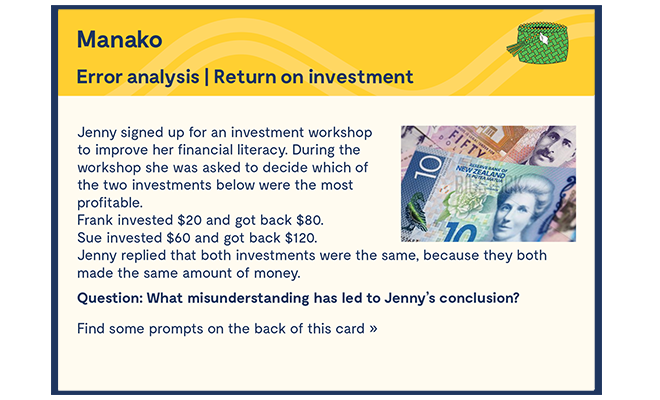Return on investment Step 2 | Why is the learner making this mistake?
Understand why Jenny made this mistake and what can be done about it.
The two investments are not the same because Frank received four times his money back, and Sue only received two times her money back. This is a common misunderstanding that learners often have. To develop an understanding of interest, returns, and financial growth, learners must become ‘multiplicative’ thinkers. We will discuss this below.
There are several types of mathematical thinking. These are:
- additive thinking
- multiplicative thinking
- proportional thinking.
These three types of mathematical thinking are represented separately in the Learning Progressions for Adult Numeracy, and they develop at different rates for different people.
Additive thinking is what you use when you add or subtract numbers. For example, if you have $10 here and $5 there, and then you find another $5, you can work out the total by adding (10 + 5 + 5 = 20). Or, if you have $110 in your bank account and you spend $15 you can use subtraction to find how much money you have (110 – 15 = 95). This type of thinking is usually the first numeracy skill people learn after learning to count. Most of us use additive thinking every day.
The second type of thinking is ‘multiplicative thinking’. This is harder and takes longer to develop. An example of multiplicative thinking is increasing the amount of food used in a recipe. For example, if you have a biscuit recipe that makes 12 biscuits, and you want to make 3 times as many biscuits you will have to multiply all the ingredients by 3.
Multiplicative thinking also involves division. If the original recipe makes 12 biscuits and you only want 4, you will divide the ingredients by 3.
Let’s look at two different problems that require different thinking.
Additive problem: What is $112 - $24?
Multiplicative problem: It take 3 cups of flour to make 12 scones, how many cups will be needed to make 36 scones?
As you can see, to solve these problems the learner has to employ different types of mental arithmetic to find the result. It will be no surprise that usually the multiplicative problems are harder. In fact, many adults can solve additive problems perfectly fine, but struggle to solve multiplicative problems.
In the ‘Return on investment’ example, Jenny is using her additive thinking to evaluate which of the investments is better. As such she has worked out the amount the two investments returned, but she has not recognised the total amount of growth from the initial amount. Jenny does not yet recognise the multiplicative nature of the situation and will need support to do so.
The solution is to help Jenny recognise the multiplicative growth. To do this we can help Jenny recognise multiplicative relationships. It is not hard to do and will be rewarding for you and your learners.

